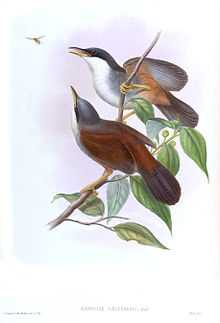Wynaad laughingthrush
| Wynaad laughingthrush | |
|---|---|
 | |
| Illustration by John Gould | |
| Conservation status | |
| Scientific classification | |
| Kingdom: | Animalia |
| Phylum: | Chordata |
| Class: | Aves |
| Order: | Passeriformes |
| Family: | Leiothrichidae |
| Genus: | Garrulax |
| Species: | G. delesserti |
| Binomial name | |
| Garrulax delesserti (Jerdon, 1839) | |
| Synonyms | |
|
Dryonastes delesserti | |
The Wynaad laughingthrush (Garrulax delesserti) is a species of laughingthrush in the Leiothrichidae family. It is endemic to the Western Ghats south of Goa in India. These laughingthrushes move in groups in dense forests, producing loud calls but tend to be hard to spot in the undergrowth. They have brown upperparts, a white throat, a broad black mask through the eye and a heavy bill with pale yellow on the lower mandible. Despite the name, derived from the Wayanad region, this species has a wider range than the two other south Indian species of laughingthrush that are restricted to the higher elevation hills.
Description
This species has dark brownish-grey upperparts, a black mask and a white throat. The breast is grey while the belly and underside are rufous. It has some resemblance to Garrulax gularis of northeastern India which has a yellow throat. Some older treatments considered lumped delesserti with gularis.[2] The ranges of delesserti and gularis are widely disjunct but museum specimens can be told apart by the pale lower mandible of delesserti unlike the all dark bill of gularis. The tail is uniformly coloured and is darker than the back in delesserti while that of gularis is pale with rufous outer tail feathers. The chin is yellow in gularis while white in delesserti.[3] The generic placement of this species has varied over time and has been placed in the past under Dryonastes and Garrulax. A 2012 phylogenetic study suggests that it should be separated from Garrulax under the genus Ianthocincla.[4][5][6]
The species is named in honour of Adolphe Delessert who collected a specimen in 1839 from near Kotagiri. Jerdon described the species as Crateropus delesserti.[7] Another description was later published by de Lafresnaye in 1840.[8]
Distribution
The Wynaad laughingthrush is patchily distributed south of Goa. Its natural habitat is subtropical or tropical moist forests. Their breeding has been recorded from the plains to the higher hills of southern India. The species has been recorded near Goa, Castle Rock, Karwar, Dandeli, near Bhatkal although it is rare in the northern part of its range.[9][10] It has been recorded in the Brahmagiris, Nilgiris,[11] and extending south to the Ashambu hills.[12]
Behaviour and ecology
The species is extremely gregarious and tends to skulk in the undergrowth. Flocks vary from six to fifteen but sometimes as many as forty birds may be present together. They feed mainly on the ground turning over leaves to find insects and fallen seed or berries. The calls are load and include shrill chattering and cackling. Other calls include churring and chirping notes and some calls resemble those of Turdoides subrufus.[13]
The peak breeding season is mainly during the monsoons, April to August in Kerala and July to September in Karnataka although they may breed at other times of the year. The nest is an untidy cup of grasses with a dome above it. It is placed low in a bush, often on Strobilanthes sp. Three eggs are the typical clutch. The eggs are very spherical and white rather than blue, a feature shared with a few other laughingthrushes such as Garrulax leucolophus.[6][13] More than a pair have been seen near a nest suggesting the presence of helpers at the nest.[14]
References
- ↑ BirdLife International (2012). "Garrulax delesserti". IUCN Red List of Threatened Species. Version 2013.2. International Union for Conservation of Nature. Retrieved 26 November 2013.
- ↑ Deignan, HG; Paynter, RA, Jr.;SD Ripley (1964). Check-list of birds of the world 10. Cambridge, Massachusetts: Museum of Comparative Zoology. p. 370.
- ↑ Collar, NJ (2006). "A partial revision of the Asian babblers (Timaliidae).". Forktail 22: 85–112.
- ↑ Moyle, RG; Andersen, MJ; Oliveros, CH; Steinheimer, FD & S. Reddy (2012). "Phylogeny and Biogeography of the Core Babblers (Aves: Timaliidae)". Systematic Biology 61 (4): 631–651. doi:10.1093/sysbio/sys027.
- ↑ Rasmussen PC & JC Anderton (2005). Birds of South Asia: The Ripley Guide. Volume 2. Smithsonian Institution & Lynx Edicions. p. 411.
- ↑ 6.0 6.1 Baker, ECS (1922). The Fauna of British India. Birds. Volume 1 (2 ed.). London: Taylor and Francis. p. 149.
- ↑ Jerdon, TC (1839). "Catalogue of the birds of the Peninsula of India". Madras Journal of Literature and Science 10: 234–269.
- ↑ de Lafresnaye, F (1840). "Oiseaux nouveaux, recueillis sur le plateau des Neelgheries, dans les Indes orientales, par M. Ad. Delessert". Revue Zoologique: 65–66.
- ↑ Davidson, J (1895). "The birds of the Bombay Presidency". J. Bombay Nat. Hist. Soc. 9 (4): 488–489.
- ↑ LaPersonne, VS (1933). "Extended distribution of the Wynaad laughing Thrush (Garrulax delesserti, Jerdon) to north Kanara.". J. Bombay Nat. Hist. Soc. 36 (2): 503–504.
- ↑ Davison, William (1883). "Notes on some birds collected on the Nilghiris and in parts of Wynaad and southern Mysore". Stray Feathers 10 (5): 329–419.
- ↑ Oates, EW (1889). The Fauna of British India. Birds. Volume 1. London: Taylor and Francis. p. 82.
- ↑ 13.0 13.1 Ali, S & SD Ripley (1996). Handbook of the birds of India and Pakistan. Volume 7. New Delhi: Oxford University Press. pp. 19–20.
- ↑ Zacharias, VJ (1997). "Possible communal nesting in the Wynaad Laughing Thrush Garrulax delesserti delesserti (Jerdon)". J. Bombay Nat. Hist. Soc. 94 (2): 414.
